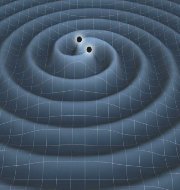Gravitational Wave Background
Telescopes around the world have made a remarkable discovery known as the “gravitational wave background.” This breakthrough, revealed in recent papers, aligns with Albert Einstein’s general theory of relativity and offers profound insights into the nature of space and time. The resulting image has exposed a universe reminiscent of a turbulent sea.
The Origin and Impact of Gravitational Waves
Gravitational waves permeate space and time, generated by densely concentrated celestial objects, particularly pairs of supermassive black holes spiraling towards each other before merging. As these waves traverse the universe, they distort and compress the fabric of space-time itself.
Einstein’s Legacy and the Quest for Evidence
In 1916, Albert Einstein theorized the existence of gravitational waves as an extension of his groundbreaking general theory of relativity, which proposed that gravity arises from the bending of space and time caused by matter. Scientists only obtained indirect evidence of these waves starting in the 1970s until their direct detection in 2016.
Pulsars and the Research BreakthroughThe recent research heavily relied on pulsars, which are the incredibly dense remnants of exploded stars spinning at an astonishing rate. A total of 68 pulsars played a crucial role in collecting the evidence supporting the existence of the gravitational wave background.
Observing the Hum of the Universe
The gravitational wave background, as described by the researchers, can be likened to hearing a multitude of voices at a party without discerning any specific individual. It represents a symphony of gravitational waves, each contributing to the overall cosmic hum.
Broadening Our Understanding of the Cosmos
While astronomers have traditionally relied on studying light to explore the universe, gravitational waves offer a deeper understanding of its intricate workings. Similar to ghostly particles called neutrinos, gravitational waves provide researchers with a more comprehensive means of unraveling the mysteries of our cosmos.
These groundbreaking findings come seven years after the initial detection of gravitational waves resulting from the collision of two distant black holes. The discovery was made possible through the Laser Interferometer Gravitational-Wave Observatory (LIGO).
Month: Current Affairs - June, 2023
Category: Science & Technology Current Affairs


